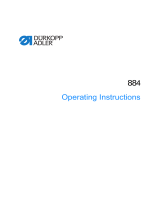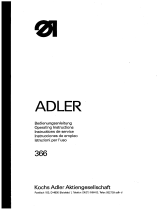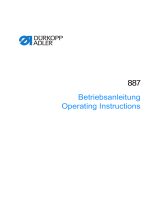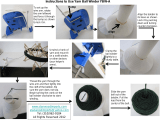Duerkopp Adler 884 Operating instructions
- Category
- Sewing machines
- Type
- Operating instructions
This manual is also suitable for

884
Operating Instructions

A
ll rights reserved.
Property of Dürkopp Adler AG and copyrighted. Reproduction or publication of the content in any manner, even
in extracts, without prior written permission of Dürkopp Adler AG, is prohibited.
Copyright © Dürkopp Adler AG - 2019

Foreword
This instruction manual is intended to help the user to become familiar
with the machine and take advantage of its application possibilities in
accordance with the recommendations.
The instruction manual contains important information on how to
operate the machine securely, properly and economically. Observation
of the instructions eliminates danger, reduces costs for repair and
down-times, and increases the reliability and life of the machine.
The instruction manual is intended to complement existing national
accident prevention and environment protection regulations.
The instruction manual must always be available at the machine/sewing
unit.
The instruction manual must be read and applied by any person that is
authorized to work on the machine/sewing unit. This means:
– Operation, including equipping, troubleshooting during the work
cycle, removing of fabric waste,
– Service (maintenance, inspection, repair) and/or
– Transport.
The user also has to assure that only authorized personnel work on the
machine.
The user is obliged to check the machine at least once per shift for
apparent damages and to immediatly report any changes (including the
performance in service), which impair the safety.
The user company must ensure that the machine is only operated in
perfect working order.
Never remove or disable any safety devices.
If safety devices need to be removed for equipping, repairing or
maintaining, the safety devices must be remounted directly after
completion of the maintenance and repair work.
Unauthorized modification of the machine rules out liability of the
manufacturer for damage resulting from this.
Observe all safety and danger recommendations on the machine/unit!
The yellow-and-black striped surfaces designate permanend danger
areas, eg danger of squashing, cutting, shearing or collision.
Besides the recommendations in this instruction manual also observe
the general safety and accident prevention regulations!

General safety instructions
The non-observance of the following safety instructions can cause
bodily injuries or damages to the machine.
1. The machine must only be commissioned in full knowledge of the
instruction book and operated by persons with appropriate training.
2. Before putting into service also read the safety rules and
instructions of the motor supplier.
3. The machine must be used only for the purpose intended. Use of
the machine without the safety devices is not permitted. Observe all
the relevant safety regulations.
4. When gauge parts are exchanged (e.g. needle, presser foot, needle
plate, feed dog and bobbin) when threading, when the workplace is
left, and during service work, the machine must be disconnected
from the mains by switching off the master switch or disconnecting
the mains plug.
5. Daily servicing work must be carried out only by appropriately
trained persons.
6. Repairs, conversion and special maintenance work must only be
carried out by technicians or persons with appropriate training.
7. For service or repair work on pneumatic systems, disconnect the
machine from the compressed air supply system (max. 7-10 bar).
Before disconnecting, reduce the pressure of the maintenance unit.
Exceptions to this are only adjustments and functions checks made
by appropriately trained technicians.
8. Work on the electrical equipment must be carried out only by
electricians or appropriately trained persons.
9. Work on parts and systems under electric current is not permitted,
except as specified in regulations DIN VDE 0105.
10. Conversion or changes to the machine must be authorized by us
and made only in adherence to all safety regulations.
11. For repairs, only replacement parts approved by us must be used.
12. Commissioning of the sewing head is prohibited until such time as
the entire sewing unit is found to comply with EC directives.
13. The line cord should be equipped with a country-specific mains
plug. This work must be carried out by appropriately trained
technicians (see paragraph 8).
It is absolutely necessary to respect the safety
instructions marked by these signs.
Danger of bodily injuries !
Please note also the general safety instructions.

Contents Page
Introduction and safety instructions
Part 1: Operating Instructions Class 884 – Original Instructions
(Edition 09.2019)
1. Product description ........................................... 5
2 Designated use .............................................. 5
3 Subclasses and sew ing equipment
3.1 Subclasses.................................................. 6
3.2 Sewing equipment standard ........................................ 7
4 Optional equipment ............................................ 8
5 Technical data ............................................... 10
6 Operation
6.1 Threading the needle thread ....................................... 11
6.2 Winding the hook thread .......................................... 12
6.3 Inserting the bobbin and threading the hook thread ......................... 12
6.4 Adjustingthethreadtension........................................ 13
6.4.1 Adjusting the hook thread tension .................................... 13
6.4.2 Adjusting the needle thread tension ................................... 14
6.5 Switching on/off the thread tensioners.................................. 16
6.6 Adjusting the thread regulator....................................... 17
6.7 Needle change................................................ 18
6.8 Liftingandfoldingtherollerpresser................................... 19
6.9 Sewing-footpressure............................................ 20
6.10 Sewing backward (feeding backward; backtacking).......................... 21
6.11 Setting the stitch length .......................................... 22
6.12 Operating the machine equipped with the positioning motor .................... 23
6.12.1 Using the pedal ............................................... 23
6.12.2 Using the key 9880 888102 ........................................ 24
6.14 Materialguide................................................ 25
6.14.1 Materialguideswitchon/off........................................ 25
6.14.2 Materialguideadjustment......................................... 26
7. Overview of positioning drives
7.1. DACbasic/classic/eco........................................... 27
7.1.1 DACbasic/classic.............................................. 27
7.1.2 DACeco ................................................... 27
7.2 Efka DA321G/DC1550 ........................................... 28
EN

Contents Page
8 Sew ing w ith machine equipped w ith positioning motor
8.1 Machineautomaticfunctions ....................................... 29
8.2 Example of machine operation at sewing ............................... 30
9. Maintenance
9.1 Cleaning and checking .......................................... 31
9.2 Lubrication .................................................. 33

EN
1 Product description
The Dürkopp Adler 884 is a special single needle sewing machine with
narrow post bed for universal use.
·
It is a double lockstitch post bed sewing machine .
·
It has a two step feed. A lower wheel feeder and a driven roller
presser feed in two steps, a needle feed feeds in the first step only.
The first step represents 33% of the total stitch length.
·
Depending on subclass, the machine may be equipped with
automatic functions such as thread trimming, automatic
backtacking, automatic foot lifting, or without them.
·
The machine is equipped with a standard two part vertical hook.
·
Maximum foot lift is 12 mm.
·
The residual thread length after thread trimming is about 8 mm.
·
A safety clutch prevents a changing of the hook setting or a hook
damage in the case of a thread deflection into the shuttle track.
·
The throat plate has replaceable inserts with the stitch hole
dimension difference, which are optional depending on the needle
size.
·
Automatic wick lubricating with an inspection glass on the arm for
machine and hook lubrication.
·
Integrated bobbin winder.
2 Designated use
The class 884 is designated for sewing shoe, leather, and upholstery
sewing. In general, the material sewn is leather (natural or artificial).
It is possible to use it for shoe fabrics too.
The equipment for light or medium heavy sewing is mounted on the
machine as an option.
It is possible to sew dry material only which may not be thicker than
7 mm when pressed down with a roller presser. The material may not
contain hard objects, as the machine is not equipped with an eye
guard. This machine may be operated in dry rooms and by a trained
person only who is aware of the risks described in this instruction.
This special sewing machine may be set up and operated only
in dry, well-maintained premises. If the sewing machine is used in
premises which are not dry and well-maintained it may be
necessary to take further precautions (which should be agreed in
advance - see EN 60204-31:1999).
As manufacturers of industrial sewing machines we proceed on the
assumption that personnel who work on our products will have
received training at least sufficient to acquaint them with all normal
operations and with any hazards which these may involve.
5

3 Subclasses and sewing equipment
3.1 Subclasses
884-150050 Single-needle double lockstitch post bed sewing
884-150050-M machine with wheel feed, needle feed with driven
roller foot and standard hook.
884-150152 Single-needle double lockstitch post bed sewing
884-150152-M machine with wheel feed, needle feed with driven
roller foot and standard hook, electro-magnetic
thread cutter, electro-magnetic seam bartacking and
sewing foot lifting.
Reduced stitch equipment: by pressing a key on the
machine head a complete stitch with shortened stitch
length is sewn.
6

3.2 Sewing equipment
¨Needle number
Polyester thread
label number
Sewing speed
Sewing equipment
For classes and subclasses
Sewing category
Scope
Standard
Scope
Standard
Maximum stitch length
Maximum
Standard*
Top roller diameter
Wheel feed tooth pitch
Noise**
0,01 mm 0,01 mm --mm 1/min 1/min mm mm dB (A)
884-E1
0884 150050
0884 150152
light 70-80 80 80-60 60 4 3000 2500
35
0,6
884-E2 medium 90-110 90 50-30 40 4 2500 2500
884-E3 light 70-80 80 80-60 60 4 3000 2500
884-E4 medium 90-110 90 50-30 40 4 2500 2500
* When sewing very thick layers, it is necessary to reduce the sewing speed significantly.
** Equivalent acoustic pressure level in the workplace.
7
EN
crosswise
groowing

4 Optional equipment
The following optional equipments are available for the class 884 :
Order No. Optional equipment Subclasses
884-150050
884-150152
9880 888101 Integrated sewing light 2 LEDs x x
incl. transformer
9880 888100 Diode sewing light 3W x x
0888 320254 Variator for continuous regulation of the difference x
between the feed wheel and the driven top roller
0688 130384 Knee lever for the sewing foot lifthing x x
9805 791113 USB-Memory-Stick for data transfer with x x
the EFKA Control DA321G
0867 490010 Bracket for the control panel x
9800 330009 Control panel V810 x
9800 330010 Control panel V820 x
N800 080030 Rectractable material guide x x
N800 080004 Rectractable roller material guide x x
0888 220334 Top roller Æ 25 mm knurled x x
0888 220344 Top roller Æ 25 mm smooth x x
0888 220354 Top roller Æ 25 mm rubberized x x
0888 220364 Top roller Æ 35 mm knurled x x
0888 220374 Top roller Æ 35 mm smooth x x
0888 220384 Top roller Æ 35 mm rubberized x x
0888 220394 Top roller Æ 45 mm, width 3,8 mm x x
0888 220404 Top roller Æ 45 mm, width 2,0 mm x x
9081 300001 Tool kits M-type x x
0888 310134 Needle feed locking x x
0867 490244 Measuring of foot pressure and upper thread tension x
0888 590014 Upgrade kit x
Stojany
MG 55 400334 Stand set MG 55-3 x x
for toothed belt drive, with pedal,
table top size 1060 x 500 mm
MG55 400324 Stand set MG 55-3 x x
for V-belt drive, with pedal,
table top size 1060 x 500 mm
8

The following optional equipments are available for the class 884-M :
Order No. Optional equipment Subclasses
884-150050-M
884-150152-M
9880 888101 Integrated sewing light 2 LEDs x
incl. transformer
9880 888100 Diode sewing light 3W incl. transformer x x
9880 888104 Integrated sewing light 2 LEDs without transformer x
9850 001089 Transformer x
0888 321274 Variator for continuous regulation of the difference x
between the feed wheel and the driven top roller
0688 130384 Knee lever for the sewing foot lifthing x x
9835 901005 Memory-Dongle - DAC Clasic control x x
N800 080030 Rectractable material guide x x
N800 080004 Rectractable roller material guide x x
0888 220334 Top roller Æ 25 mm knurled x x
0888 220344 Top roller Æ 25 mm smooth x x
0888 220354 Top roller Æ 25 mm rubberized x x
0888 220364 Top roller Æ 35 mm knurled x x
0888 220374 Top roller Æ 35 mm smooth x x
0888 220384 Top roller Æ 35 mm rubberized x x
0888 220394 Top roller Æ 45 mm, width 3,8 mm x x
0888 220404 Top roller Æ 45 mm, width 2,0 mm x x
9081 300001 Tool kits M-type x x
0888 310134 Needle feed locking x x
0867 490244 Measuring of foot pressure and upper thread tension x
0888 590014 Upgrade kit x
Stojany
MG 55 400334 Stand set MG 55-3 x x
for toothed belt drive, with pedal,
table top size 1060 x 500 mm
x = Optional equipment
o = Standard equipment
Additional optional equipments can be requested at our Application
Center (APC).
E-Mail: marketing@duerkopp-adler.com
9
EN

5 Technical parameters
Stitch type double lockstitch 301
Needle system 134LR, 134 KKLR, 134, 134 D
Foot lifting with a hand lever 6 mm
Foot lifting with a knee lever or automatically 12 mm
Thread length after trimming max. 8 mm
Machine head clearance height 300 mm
Machine head clearance width 280 mm
Machine base plate plan dimensions 178 x 518 mm
Table top plan dimensions 1060 x 500 mm
Table top minimum height 740 mm
Table top maximum height 900 mm
Machine height max. 1630 mm
Maximum input (short-time) 0,8 kW
Weight of stand 30 kg
Weight of motor EFKA DC 1550 10 kg
Weight of machine head with DAC 54 kg
10

6 Operation
6.1 Threading the needle thread
Caution! Risk of injury!
Turn off the main switch.
The needle thread may only be threaded with the sewing machine
switched off.
–
Thread the machine according to picture.
11
EN

6.2 Winding the hook thread
–
Thread the thread according to the picture.
–
Insert the thread under the knife (1) and tear off by pulling in the
arrow direction (2).
–
Fix the bobbin and press the lever (3) in the direction (4).
–
Start the machine up.
–
After the thread winding, slide the thread under the knife (1) again
and tear it off.
–
Insert another bobbin immediately and press the lever (3).
6.3 Inserting the bobbin and threading the hook thread
Caution! Risk of injury!
Switch the main switch off and wait till the motor stops.
–
Tilt the shutter (1) up.
–
Insert the bobbin (2) with the thread end (3) oriented according to
the picture.
–
Thread the thread through the slit (4) and space (5), hook upon the
shutter (1) and fasten it under the spring (6).
–
Draw the thread in the sewing direction to the throat plate corner
(about 40 mm).
–
Close the cover of hook (7).
–
Cut the protruding thread.
12
2
31
4
2
3
4
6
5
7
1

6.4 Adjusting the thread tension
6.4.1 Adjusting the hook thread tension
Caution! Risk of injury!
Turn off the main switch.
The hook thread tension may only be adjusted with the machine
switched off.
–
Adjust the hook thread tension via the screw (1). Increase the
tension by tightening the screw.
–
Measure the thread tension with a dynamometer. Thread the
thread according to the picture and pull in the arrow direction (2).
This tension is adjusted in the factory in dependence on the
selected sewing equipment according to the table below, and it is
suitable for the usual sewing operations.
For sewing thin soft materials, it is necessary to reduce the
tension. If the seam is to be tightened strongly, it is necessary to
increase the tension and reduce the sewing speed at the same
time.
Hook thread tension mean value
Sewing category Used needle size Thread tension in
grams
light 70 - 80 50
medium 90 - 110 65
13
EN
1
2

6.4.2 Adjusting the needle thread tension
Adjusting the pre-tensioner (1)
–
Adjust the supplementary tensioner (1) so that it has the lowest
tension possible, but so high that, when taking out the sewn
material after the preceding trimming (when the tensioners (2) and
(3) are switched off), the thread is not pulled out of the tensioner
(1). (Tensioner (1) is not switched off at the foot lifting).
Adjusting tensioners (2) and (3)
ECO and CLASSIC machines with electro-magnetic control
–
The machine can be equipped with a lever (4) for the tensioner (2)
temporary switching off. In this case, two thread tension values can
be pre-selected and a good stitch tightening can be achieved when
sewing over a variable number of layers of the sewn material with
one seam.
–
Switch the tensioner off (2) with the lever (4) and sew on a smaller
number of layers.
–
Regulate the thread tension with the tensioner (3), till a good
thread loop is achieved (see below).
–
Switch the tensioner on (2) by the lever (4) shifting out and sew on
a greater number of layers.
–
Regulate the thread tension with a tensioner (2), till a good thread
loop is achieved (see below).
–
If the machine is not equipped with the lever (4), regulate the
tension by both tensioners (2) and (3) at the same time so that their
nuts are screwed approximately in the same height.
14
1
2
3
4

Correct thread interlacing in the center of the
material
Needle-thread tension too weak
or
hook-thread tension too strong
Needle-thread tension too strong
or
hook-thread tension too weak
15
EN

6.5 Switching on/off the thread tensioners
ECO and CLASSIC machines with electro-magnetic control
–
When pulling the hand lever (1) towards the operator, the
tensioners (3) and (4) are switched off.
–
Tensioner (2) is never switched off.
Manually controlled machines (without the thread trimming)
–
Tensioners (3) and (4) are mechanically switched off when the foot
is lifted with a hand or knee lever.
Machines with the thread trimming
–
Tensioners (3) and (4) are switched off with an electric magnet at
the foot automatic lifting. If the automatic foot lifting at the machine
stop is pre-selected, the tensioners are switched off, but
temporarily only, so that the switching off electric magnet does not
overheat.
–
Tensioners (3) and (4) are also switched off temporarily during the
trimming cycle.
–
Tensioners (3) and (4) are not switched off at the foot lifting with
the hand or knee lever.
16
1
2
3
4

6.6 Adjusting the thread regulator
The thread regulator (2) controls the quantity of needle thread required
for stitch formation.
The thread regulator must be precisely adjusted for an optimum result.
–
Loosen the screw (1), shift the thread regulator (2), and tighten the
screw (1).
–
For most of the sewing operations, the thread regulator optimal
setting is with its right edge set to “2".
–
The setting “3" or ”4" is suitable for thin materials and very short
stitches only.
17
EN
2
1
1234

6.7 Needle change
Caution! Risk of injury!
Replace the needle with the main switch switched off and the motor
stopped.
–
Draw the lever (1) in your direction to loosen the screw fixing the
needle.
–
Remove the needle and insert a new one with the needle scarf (2)
to the right /see section (3) or (4)/. The needle may not be oriented
as shown at section (5).
–
Turn the lever (1) back to tighten the screw fixing the needle.
Caution! Danger of breakage!
A false orientation of the needle may damage the hook point.
When changing to another needle size, the distance between hook
and needle, as well as the position of the throat plate towards its post
must be readjusted (see service instructions).
18
1
2
3
4
5
MAX. 3°
Page is loading ...
Page is loading ...
Page is loading ...
Page is loading ...
Page is loading ...
Page is loading ...
Page is loading ...
Page is loading ...
Page is loading ...
Page is loading ...
Page is loading ...
Page is loading ...
Page is loading ...
Page is loading ...
Page is loading ...
Page is loading ...
Page is loading ...
Page is loading ...
Page is loading ...
Page is loading ...
Page is loading ...
Page is loading ...
Page is loading ...
Page is loading ...
Page is loading ...
Page is loading ...
Page is loading ...
Page is loading ...
Page is loading ...
Page is loading ...
Page is loading ...
Page is loading ...
Page is loading ...
Page is loading ...
Page is loading ...
Page is loading ...
Page is loading ...
Page is loading ...
-
 1
1
-
 2
2
-
 3
3
-
 4
4
-
 5
5
-
 6
6
-
 7
7
-
 8
8
-
 9
9
-
 10
10
-
 11
11
-
 12
12
-
 13
13
-
 14
14
-
 15
15
-
 16
16
-
 17
17
-
 18
18
-
 19
19
-
 20
20
-
 21
21
-
 22
22
-
 23
23
-
 24
24
-
 25
25
-
 26
26
-
 27
27
-
 28
28
-
 29
29
-
 30
30
-
 31
31
-
 32
32
-
 33
33
-
 34
34
-
 35
35
-
 36
36
-
 37
37
-
 38
38
-
 39
39
-
 40
40
-
 41
41
-
 42
42
-
 43
43
-
 44
44
-
 45
45
-
 46
46
-
 47
47
-
 48
48
-
 49
49
-
 50
50
-
 51
51
-
 52
52
-
 53
53
-
 54
54
-
 55
55
-
 56
56
-
 57
57
-
 58
58
Duerkopp Adler 884 Operating instructions
- Category
- Sewing machines
- Type
- Operating instructions
- This manual is also suitable for
Ask a question and I''ll find the answer in the document
Finding information in a document is now easier with AI
Related papers
-
 Duerkopp Adler 884 Operating instructions
Duerkopp Adler 884 Operating instructions
-
 Duerkopp Adler 267_valid_till_March_2016 User manual
Duerkopp Adler 267_valid_till_March_2016 User manual
-
 Duerkopp Adler 888 User manual
Duerkopp Adler 888 User manual
-
 Duerkopp Adler 366 Operating instructions
Duerkopp Adler 366 Operating instructions
-
 Duerkopp Adler 887-M Operating instructions
Duerkopp Adler 887-M Operating instructions
-
 Duerkopp Adler 887 Series Operating instructions
Duerkopp Adler 887 Series Operating instructions
-
 Duerkopp Adler 550-16-26 Installation guide
Duerkopp Adler 550-16-26 Installation guide
-
 Duerkopp Adler 609 Owner's manual
Duerkopp Adler 609 Owner's manual
-
 Duerkopp Adler 550-16-26 Owner's manual
Duerkopp Adler 550-16-26 Owner's manual
-
 Duerkopp Adler 69_valid_till_october_2019 Installation guide
Duerkopp Adler 69_valid_till_october_2019 Installation guide
Other documents
-
DURKOPP ADLER 827 Owner's manual
-
Siruba C007KP Instruction book
-
Barco Coronis Fusion 6MP DL (MDCC-6130) Installation guide
-
Siruba C007L C007LX Instruction book
-
SunStar KM-1072 SERIES User manual
-
Siruba 700KS LF-D6K1 Instruction book
-
Siruba 700KD/700LD Simple type Owner's manual
-
SunStar SPS/E-BR1201 Series User manual
-
DURKOPP ADLER 888-M Operating instructions
-
 Stanwood Needlecraft YBW-A User guide
Stanwood Needlecraft YBW-A User guide




































































